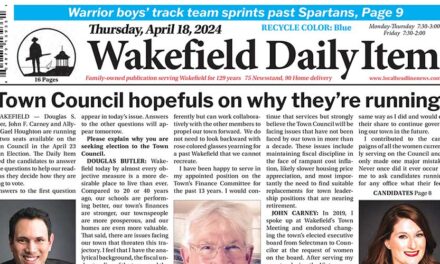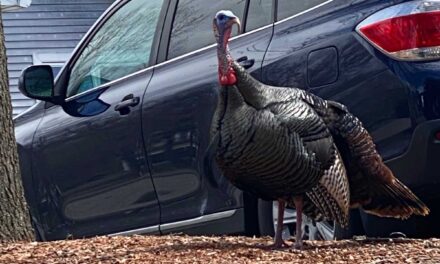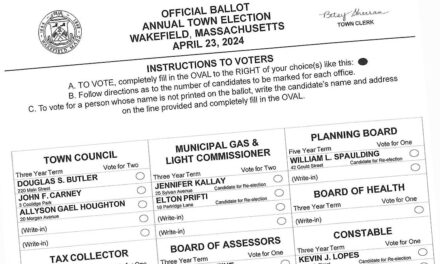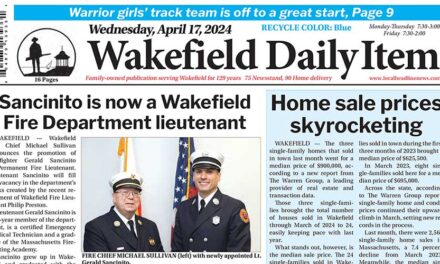Published in the March 15, 2017 edition
WAKEFIELD — A howling nor’easter dumped about nine inches of wet, heavy, difficult-to-move snow on the town yesterday, while also bringing sleet and rain, which didn’t do Wakefield’s trees, streets and driveways much good.
All that moisture froze overnight as temperatures in the area plummeted into the 20s. What wasn’t cleaned off by homeowners by about 7 p.m. soon turned into packed-down ice.
Wakefield’s schools operated on a regular schedule this morning after begin closed Tuesday. Trash and recycling collection will be delayed a day for the rest of the week. Various meetings, like last night’s budget meeting of the School Committee, were postponed.
The town’s had a parking ban in effect for all streets through noon today. Yesterday, the Police Department spent a good chunk of its morning making sure that vehicles parked on public ways were towed away so the snow removal operations could proceed.
According to DPW Director Richard Stinson, moving the snow around was difficult but he reported no major breakdowns with any pieces of equipment, either contracted or town-owned.
Crews went out yesterday morning around 3 to pre-treat streets and began plowing around 10 a.m. Snow and then a sleet-mixture fell until about 5 p.m. and then came the rain. The strong winds continued into the evening.
Snow removal operations continued until about 9 p.m. Crews then salted town roads twice overnight, from about 10 p.m. to 2 this morning, and again today from 3:30 a.m. to about 7 a.m.
Because of the extremely windy conditions mixed with heavy snow and then rain, the DPW hired a private tree contractor to help deal with downed limbs and trees.
At 2:45 p.m. yesterday, branches and wires were reported down on Middlesex Street. A Municipal Gas and Light Department crew responded.
At about 3 p.m. police were told that a downed tree had caused power to go out at a residence on Woodbriar Road. The Municipal Gas and Light Department responded.
Trees and wires were down in Elm Square around 3:40 p.m.
Trees and wires were down on Rockland Street around 4:30 p.m., with the DPW and the light department both responding.
A tree and wires were down on Eustis Avenue around 4:35 p.m.
A tree was reported into a house on Bay State Road just before 6 p.m.
Municipal Gas and Light Department General Manager Peter Dion said today that despite the severity of the storm, there were only a few isolated outages.
The Eustis Avenue incident mentioned above took out power to about 20 customers for close to two hours, Dion said.
On Pleasant Street in the late afternoon, about 20 more customers lost power for about an hour.
“Tree trimming really works and we survived the storm pretty well,” Dion said.
Elsewhere in the region, plunging temperatures ushered in by the storm that plastered the Northeast turned the snow and sleet into rock-solid ice, leaving roads and sidewalks treacherous Wednesday and making shoveling seem like hard labor.
Tuesday’s powerful nor’easter paralyzed much of the Washington-to-Boston corridor, but fell short of the predicted snowfall totals in New York, Boston and Philadelphia.
The storm, which followed a stretch of unusually mild winter weather, dumped 1 to 2 feet in many places, grounded more than 1,000 flights Wednesday after 6,200 flights were canceled a day earlier. It also knocked out power to nearly a quarter-million customers from Virginia northward.
By the time it reached Massachusetts, it had turned into a blizzard, with near hurricane-force winds gusting to over 70 mph along the coast. Boston ended up with 6.6 inches of snow, far less than what was predicted.
Boston canceled school for a second day Wednesday to allow time for cleanup efforts. Mayor Marty Walsh said he made the call out of “an abundance of caution.”
The storm was easily the biggest in an otherwise merciful winter that had mostly spared the region. Many, like retired gumball machine technician Don Zimmerman, of Lemoyne, Pennsylvania, weren’t happy.
“It’s horrible,” Zimmerman said, using a snowblower to clear the sidewalk along his block. “I thought winter was out of here. … It’s a real kick in the rear.”
While most people heeded the warnings to stay off the roads, police said a 16-year-old girl was killed when she lost control of her car on a snowy road and crashed into a tree in Gilford, New Hampshire.
In East Hartford, Connecticut, an elderly man died after being struck by a snow plow truck. And, in Longmeadow, Massachusetts, a public works employee was killed after the snow plow he was driving was hit by an Amtrak plow train clearing tracks.
The storm closed schools in cities big and small, Amtrak suspended service and the post office halted mail delivery. The number of flight cancellations reached more than 3,000 in the New York City area alone, stranding hundreds of passengers.
The storm was on track to be one of the biggest on record for Burlington, Vermont, which got 25.6 inches of snow as of Wednesday morning, with another 2 to 5 inches due by the end of the day. About 70 miles to the northeast, Jay led the way with 34 inches.
Philadelphia and New York City got anywhere from a few inches of snow to around half a foot before it switched over to sleet. Forecasters had predicted a foot or more. In New Jersey, which saw rain or just a little snow, Gov. Chris Christie called the storm an “underperformer.”
Inland areas, meanwhile, got hit hard. Harrisburg, Pennsylvania, and Worcester, Massachusetts, received a foot or more of snow. The Binghamton, New York, area got over 2 feet, while Vernon, New Jersey, had at least 19 inches.
The storm came just days after the region saw temperatures climb into the 60s, and less than a week before the official start of spring.
In the nation’s capital, non-essential federal employees were given the option of reporting three hours late, taking the day off or working from home. The city got less than 2 inches of snow.
A few days ago, workers on Washington’s National Mall were making plans to turn on the fountains.
“Obviously all that has to come to an abrupt stop until we get all the snow cleared,” said Jeff Gowen, the acting facility manager for the National Mall and Memorial Parks. “The cherry blossoms, they’re right on the cusp of going into bloom here. I had a feeling this was going to happen.”
As the storm closed in, the National Weather Service used terms like “life-threatening” and urged people to “shelter in place,” language that has come to be associated with mass shootings. In the end, the line between snow and rain shifted slightly to the west, sparing some of the Northeast’s big cities.
Government meteorologists realized by late Monday afternoon that there was a good chance the storm wasn’t going to produce the giant big-city snow totals predicted. But they didn’t change their forecast for fear people would mistakenly think the storm was no longer dangerous, said Greg Carbin, chief of forecast operations at the Weather Prediction Center.
In Narragansett, Rhode Island, high winds buckled a state-owned wind turbine. In New York City, two homes under construction collapsed near the waterfront in Far Rockaway. No injuries were reported.
And two ponies broke out of their stables and roamed the snowy streets of Staten Island until an off-duty police officer wrangled them with straps normally used to tow cars and tied them to a lamppost. They were taken back to the stables.
The storm coincided with New Hampshire’s Town Meeting Day, a Yankee tradition in which voters in more than 100 communities elect local politicians and set budgets.
Some towns postponed the meetings because of the snow. But in Hopkinton, a steady stream of voters braved the blustery conditions.
“You know, they’re hardy New Englanders, and they’re coming to vote,” said Debbie Norris, a candidate for the Hopkinton Budget Committee.
—–
The Associated Press contributed to this report.




